Hong Kong Monetary Authority Annual Report 1997
MONETARY STABILITY
Notwithstanding the worst financial turmoil in the history of Asia which erupted in the second half of 1997, the exchange rate of the Hong Kong dollar remained reasonably stable under the linked exchange rate system. Indeed Hong Kong dollar is the only freely convertible currency in the region which has survived the turmoil unscathed.
OBJECTIVE
The overriding monetary policy objective in Hong Kong is currency stability defined in terms of a stable external value for the Hong Kong dollar against the US dollar at the rate of HK$7.80 to US$1 under the linked exchange rate system.
The linked exchange rate system is a currency board arrangement, which requires the monetary base to be fully backed by the foreign currency to which the domestic currency is linked at a fixed exchange rate. The monetary base is usually defined as the sum of the amount of banknotes in circulation and the balance of the banking system held with the central bank for effecting the clearing and settlement of transactions among banks and those between the banks and the central bank. In the case of Hong Kong where the foreign currency assets of the Exchange Fund and the Land Fund amounted to US$92.8 bn (as at end-1997), the monetary base was more than seven times backed by foreign currency assets.
The currency board system operates with a self-adjustment mechanism to restore exchange rate stability when it comes under pressure. Specifically, when there is an inflow of funds, the foreign currency to which the domestic currency is linked (US dollar in Hong Kong's case) is sold to the central bank, the monetary base will expand. In the other direction, when there is an outflow of funds and the domestic currency is sold to the currency board, the monetary base will contract. The expansion and contraction of the monetary base will cause domestic interest rates to fall or rise respectively, creating the monetary conditions to counteract the initial capital flows to restore exchange rate stability.
ACHIEVEMENTS
The Hong Kong dollar held up remarkably well to the challenges in 1997. The foreign exchange and money markets reacted calmly to the death of Deng Xiaoping in February and the resumption in the exercise of sovereignty by China over Hong Kong on 1 July. During the first half of 1997, the Hong Kong dollar exchange rate moved within a narrow range of 7.73 to 7.75 (Chart 1). The interbank term rates stayed close to their US dollar counterparts. At the longer end of the yield curve, there was a noticeable compression in the spread between the yields of the Exchange Fund paper and US Treasuries of corresponding maturities.
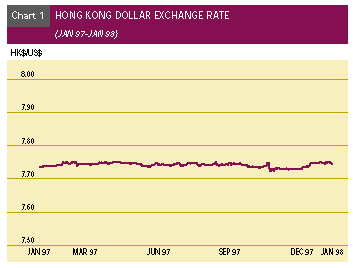
THE OCTOBER EPISODE
The floating of Thai Baht in early July 1997 sparked off the Asian financial turmoil which subsequently swept across East Asia. Affected by the contagion effects of the regional turbulence, the Hong Kong dollar came under bouts of speculative attacks since July. Selling pressure on the Hong Kong dollar intensified during the week of 20 October following the decision by the Taiwanese authorities not to defend the New Taiwan dollar. In addition to speculative shorting of the Hong Kong dollar, there was a considerable amount of hedging by overseas investors.
In line with the currency board discipline, the HKMA passively sold amounts of US dollars on 21 and 22 October. The settlement of these deals would involve the HKMA debiting the clearing accounts of those banks selling the Hong Kong dollars to it. To discourage the use of LAF to fund a short Hong Kong dollar position, the HKMA issued a circular on the morning of 23 October reminding banks that they should organise their Hong Kong dollar funding prudently and not be overly dependent upon the LAF for last resort liquidity support. The circular also warned them that the HKMA might impose penal LAF rates for repeated borrowers.
As the banks collectively had sold more Hong Kong dollars to the HKMA than they could settle by using their credit balances in their clearing accounts with the HKMA, there was an acute shortage of interbank liquidity when these foreign exchange transactions were settled on 23 October. Given that the banks did not wish to resort to LAF on a repeated basis, interbank interest rates shot up and overnight HIBOR briefly touched 280%.
The interest rate hike quickly stemmed the capital outflow and the HKMA started to pick up US dollars in the afternoon on 23 October, as speculators unwound their speculative short position in Hong Kong dollar. There was also some inflow of funds to take advantage of higher Hong Kong dollar interest rates. The Hong Kong dollar rebounded sharply from 7.75 in the morning to 7.6 at noon time. In accordance with the currency board arrangement, the purchase of US dollar by the HKMA, some of which were for value the same day entailed an increase in liquidity of the interbank market. In response, overnight HIBOR eased to around 100% by close of 23 October and quickly dropped to around 5% on the following day (Chart 2).
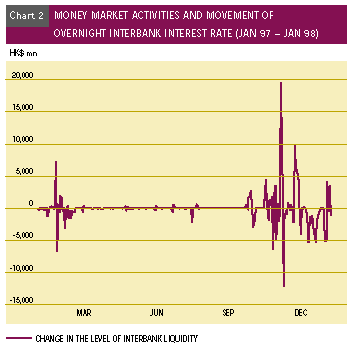
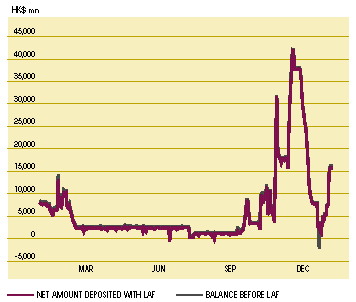
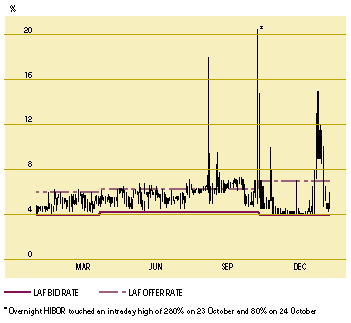
Along with the rise in interbank interest rates, the savings deposit rate governed by the HKAB Rules and the BLR quoted by major banks were raised by 75 bp on 24 October.
On 25 October, the HKMA widened the band of the LAF corridor from 200 bp to 300 bp and adjusted the LAF bid and offer rates to 4% and 7% respectively as a wider LAF corridor would provide more room for overnight HIBOR to move in view of the increased volatility of the interbank market.
THE AFTERMATH
While overnight HIBOR quickly eased to around 5% after the hike on 23 October, interbank term rates continued to stay at relatively high levels in late October and early November because banks sought to conserve liquidity for fear of another liquidity squeeze. The one-month rate, for instance, moved around 15%, producing a steep yield curve from the overnight to the one-month area. To remove market uncertainty, the HKMA clarified the definition of 'repeated borrowers' in respect of LAF borrowing on 12 November. 'Repeated borrowers' are defined as those which have borrowed through LAF on eight occasions in any period of 25 days or on four consecutive days. If a repeated borrower fails to provide a satisfactory explanation of his repeated use of LAF and continues to borrow, a penal rate may be charged on his future borrowing. Helped by the above clarification as well as an inflow of funds, interbank term rates started to come down since the latter part of November. However, reflecting the Asian risk premium, there remained a significant differential between the Hong Kong dollar and the US dollar interest rates (Chart 3). As at end-1997, the one-month rate stood at 7.25%, 153 bp above one-month London Interbank Offer Rate (LIBOR).
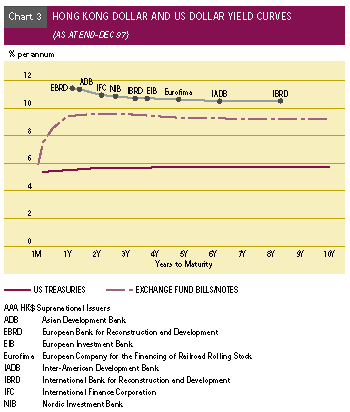
Following the October episode, the Hong Kong dollar exchange rate remained very stable, trading within a narrow range of 7.725 to 7.750 against the US dollar during the rest of the year. This stability was achieved notwithstanding a further worsening of the regional financial turmoil caused by a sharp depreciation of the Korean Won to 1,960 and the financial problems in Japan.
CHALLENGES
MAINTAINING CURRENCY STABILITY
The successful defence of the Hong Kong dollar in October 1997 showed that the currency board system was operating well. The interest rate hike under the autopilot mechanism has inevitably inflicted some pain on the economy, in particular the asset markets which showed signs of exuberance before the October episode. There was nevertheless strong consensus on the need to maintain the linked exchange rate system as an anchor of monetary and financial stability in Hong Kong.
As the external environment remained unsettled, selling pressure on the Hong Kong dollar re-emerged in January 1998 when the Indonesian Rupiah depreciated sharply to a low of 18,000. Besides, some of the earlier inflows were reversed as the interest rate differential started to narrow since late November. The outflows from the Hong Kong dollar were once again stemmed by the higher interest rate and the shrinkage of Hong Kong dollar liquidity that resulted from these outflows. Compared with October 1997, the interest rate hike in January 1998 was much more moderate, helped by the clarification of the definition of 'repeated borrowers' in the use of LAF, which prevented an over-reaction by the banks in response to sudden tightening in money market conditions.
REVIEW OF CURRENCY DEFENCE
Since the adoption of the linked exchange rate system in 1983, reform measures have been introduced from time to time to improve the effectiveness and robustness of the system. Following recent Asian financial turmoil, the HKMA has taken the opportunity to conduct another review of the currency defence, with the benefit of input from the IMF, academics, analysts and the market practitioners. The main findings of review were published in April 1998.